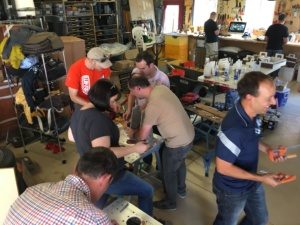Big Orange Square Build Party – Retrospective
Modules & Stand-Ups
 Working for a full day with an international team on a real product generates unique insights. Scrum contributes to product development, and to teamwork. Here are a few first remarks from attendees. After the first CSM for Hardware class the whole team participated in an extra day with a Big Orange Square Build Party. About 20 people, mostly in product development, and the youngest only 14 years old, worked on a real car. This fun Saturday brought the theory and exercises from the class to the real world of building a real car. You can find the ideas and structure here on the website.
Working for a full day with an international team on a real product generates unique insights. Scrum contributes to product development, and to teamwork. Here are a few first remarks from attendees. After the first CSM for Hardware class the whole team participated in an extra day with a Big Orange Square Build Party. About 20 people, mostly in product development, and the youngest only 14 years old, worked on a real car. This fun Saturday brought the theory and exercises from the class to the real world of building a real car. You can find the ideas and structure here on the website.








